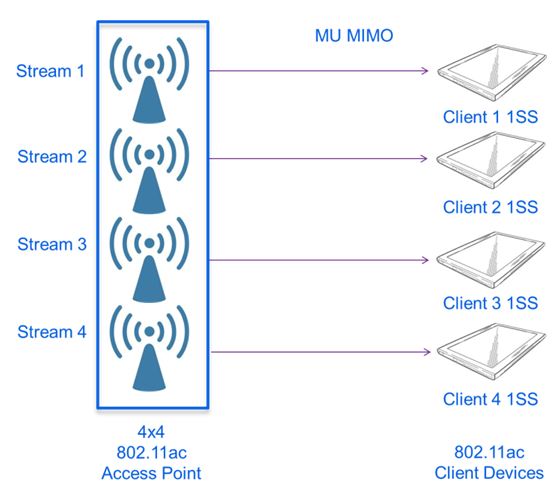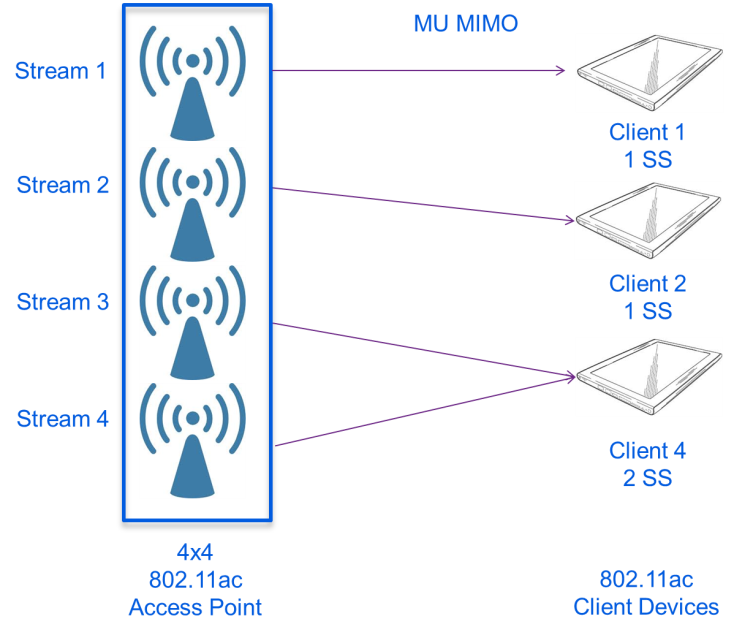































If you recall, back in the early days of 802.11n, the Wi-Fi Alliance (WFA) rolled out the 802.11n certification program in phases. Here we are several years later and in that same fashion, the WFA has split the IEEE 802.11ac specification into two certification phases: Wave 1 and Wave 2.
Last week we announced the availability of our 802.11ac Wave 1 Module for the 3600 Access Point and along with that, our intention to develop an 802.11ac adaptive radio module that will support the second phase of 802.11ac, or Wave 2. Most of the 802.11ac discussion in the last year has been focused on Wave 1, so we want to kick off the conversation about the second phase, Wave 2.

If Wave 1 promises increased wireless performance to address the increasing demand for higher performance including growing number of clients demanding higher performance for applications such as HD video streaming, then Wave 2 will stun you with its ability to provide even more throughput beyond the 1.3Gbps that Wave 1 provides as well as a number of other features that will further improve wireless connectivity. It is like taking a really good rock song and adding more cowbell to it.
SNL jokes aside, with the additional features packaged in Wave 2 comes the opportunity for further innovation in Cisco's Wireless portfolio. We feel that it is important to stay ahead of the technology curve so that customers can plan and benefit from these advances sooner rather than later. So let's discuss what features are coming with 802.11ac Wave 2.
MU-MIMO
With 802.11n, a device can transmit multiple spatial streams at once, but only directed to a single address. For individually addressed frames, this means that only a single device (or user) gets data at a time. This is referred to as single-user MIMO (SU-MIMO). With the advent of 802.11ac, a new technology is defined, called multi-user multiple input, multiple output (MU-MIMO). MU-MIMO or Multi-User MIMO is the ability of the Access Point to transmit to several clients simultaneously.
Here an 802.11ac Access Point that supports Wave 2 is able to use its antenna resources to transmit to multiple clients, all at the same time and over the same frequency spectrum. If 802.11n is like a hub, then 802.11ac MU-MIMO can be thought of to have switch like behavior.

More Spatial Streams
802.11ac Wave 2 calls for in increase in up to 8 spatial streams. However, it is expected that Wave2 implementations are likely to increase the number of spatial streams from 3 to 4, while expanding the channel width from 80 MHz to 160 MHz. The support of additional spatial streams allows for increased performance. However, combining the additional spatial streams with MU-MIMO creates a more powerful way for Access Points to communcte with clients; whether they are single spatial streams or multi-spatial stream clients. Specifically the number of concurrent clients the AP is able to communicate with is equal to or less than the number of spatial streams supported by the AP. For example, if an AP supports 4SS (spatial streams) in an MU-MIMO environment, typically that AP would be able to connect a number of clients supporting multi & single spatial streams, as long as the total#of client spatial streams add up to the maximum number of spatial streams supported on the Access Point. A picture is worth a thousands words so here are 2 diagrams that show different client scenarios connecting to an Access Point that supports 4 Spatial Streams.


Wider Channels
Wave 2 of 802.11ac is likely to expand the channel width from 80 MHz to 160 MHz. Wider channels provide the opportunity for even more throughput, with the potential for up to 160 MHz of spectrum utilized as a single pipe when communicating with wireless devices. It remains to be seen what types of client devices will support and enable 160 MHz wide channels. However, it is not unreasonable to think about utilizing wider channels in point to point and backhaul scenarios. There is also the discussion about available spectrum that comes into play depending on where you are in the world and what regulatory rules apply to the location defining how much spectrum in 5 GHz is available. This is a topic we'll save for an additional blog in the near future.

In the chart above, you can see that more spatial streams combined with wider channels can yield a higher data rate with 802.11ac Wave 2. You can also see a range of features and functions which are being looked at by all of the chip set vendors as they plan for what their implementation for 802.11ac Wave 2 will look like.
In terms of a timeline, it is expected that the IEEE 802.11ac standard will be fully ratified in early 2014 while the WFA certification for wave 2 follows in late 2014. With this in mind, Cisco is keeping a close eye on the second phase of the 802.11ac certification program and will be weighing which options will end up supported in the Wave 2 Module based upon our customers' need and how they will benefit. As we continue our development and get closer to a release date, we will have further information on the support of the Wave 2 features.
Stay tuned!
 Etiquetas calientes:
802.11ac
access point
802.11
LAN
controller
cleanair
IEEE
mu-mimo
multi-in multi-out
Etiquetas calientes:
802.11ac
access point
802.11
LAN
controller
cleanair
IEEE
mu-mimo
multi-in multi-out